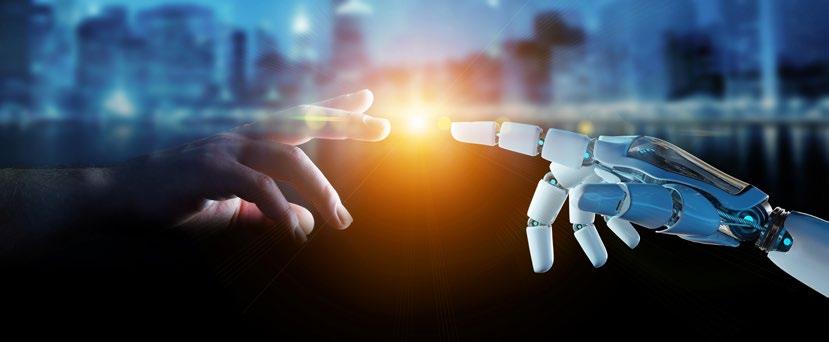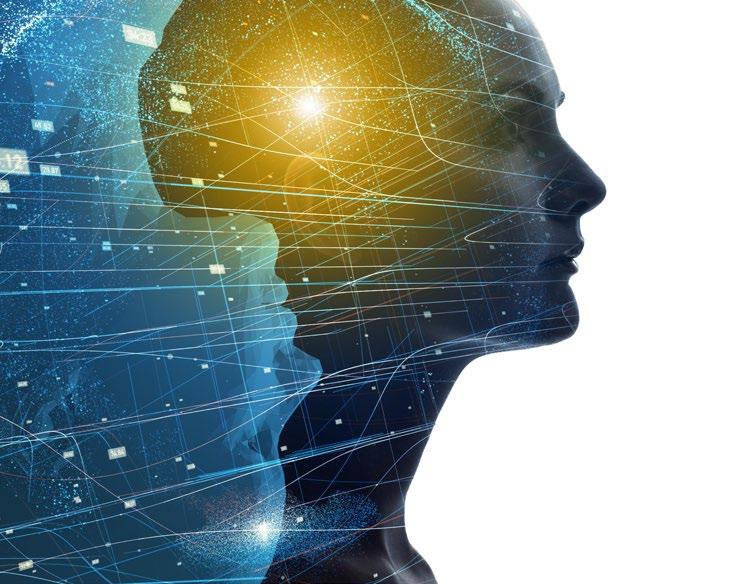
5 minute read
Interaction between human and machines - Guillermo Caletti, Ph.D.
ARTIFICIAL INTELLIGENCE (AI) AS A CORE COMPONENT FOR FUTURE MAN-MACHINE INTERFACE SYSTEMS
Human-Machine Interface (HMI) encompasses how humans and computers communicate with each other. It includes hardware and software used to translate the input from the user in commands and present the output to it.
Advertisement
The relationship between humans and machines is mainly influenced by the everincreasing capabilities of artificial intelligence. AI provides systems the ability to analyze their environment and make decisions with some degree of autonomy to achieve goals. Although the limits of AI are uncertain and have changed over time, automating, or replicating intelligent behavior is one of the key targets of AI research in these applications. This is how the proof proposed by the British investigator Alan Turing came about in 1950. The aim was to determine whether a machine could think so that a person talking concurrently to another and with a computer would not be able to distinguish their responses.
AI relies on the collection of big, fast, and complex data (Big Data), powerful computers to analyze it, and an informatic cloud to provide distributed computing resources and high-speed connections to link several sensors and information sources. Machine Learning or Automatic Learning is the most important field, referring to the development of digital systems that improve computer performance on a particular task over time through experience. Automatic learning describes the ability of software/computer to learn from its environment or a large batch of representative data, and adapt its behavior to changing circumstances accordingly, or to perform tasks for which it was not explicitly programmed. The basic idea is to enable associative learning by linking simple information processing units and artificial neurons in such a way that the weighing of connections and the relevant network performance are automatically adjusted.
People and machines produce ten times more new data every day than exists in all the books around the world. This will increase at least 100-fold by 2030. The increasing amount of digital material on the Internet in the form of images, text, videos, and audio files is used to identify patterns. The formation of multi-layers architectures on a large amount of data, which will be more important by 2030 is known as "Deep Learning". Stuart Russell and Peter Norvig use the following classification to categorize Artificial Intelligence: (1) systems that think like humans, (2) systems that behave like humans, (3) systems that think rationally, and (4) systems that act rationally (Russell & Norvig 2009).
By 2030, we will see an increasing number of HMI systems acting rationally. We may even see systems that deliberate along rational lines. Nevertheless, it will be too early for them to behave like human beings or even think like a person.
By 2030, HMI systems that act rationally will continue to function only within the narrow context of a specific problem or application. They can show excellent results, but the benefits are significantly impacted if the task is modified, even marginally. While a person who can read Japanese characters can also understand the language, expand their sushi or sashimi preferences with specific restaurant recommendations, and be aware of wearing pink slippers to the bathroom, these tasks will require different HMI systems.

OBJECTIVES FOR FUTURE HMI SYSTEMS
The human ability of creativity, improvising, cooperating, and ingenuity opens up new possibilities to engage and participate in the creation of valuable processes. New technologies could not only create the need for different goods and services, but they could also take over repetitive, physically demanding, and dangerous control. This would allow people to spend their time on other activities, such as pursuing their interests and doing meaningful things for them.
According to Daniel Newman & Olivier Blanchard (2019), the winners of the future will be those who identify how to harness the power of automation and artificial intelligence collaboratively. It represents a continuation of the long evolutionary development of human beings creating tools to solve problems they are not able to solve on their own. It is a question of task automation as opposed to job automation, recognizing that traditional roles can be divided into elements to which humans or machines are better suited.
A key element is the ability to divide larger tasks into smaller parts, distribute those parts within a large network or workers according to their availability and skills, and then synthesize the results. Digital technologies in an interconnected world make it increasingly possible to collect accurate data on the output and productivity of both individuals and teams and to compare them. This data serves as the basis for the creation of algorithms for efficient task distribution. At the same time, this makes possible a new type of Taylorism, associated with the potential for increased stress for individual and greater loss of privacy.
The objectives of HMI systems are to improve learned models with an explanatory and corrective interface, increasing the reliability of results, working with a high degree of transparency, and going beyond limited capabilities to develop skills that can be assigned to broader tasks. This would make it possible to communicate naturally with people and extrapolate past experiences to constantly solve new tasks and situations. Achieving this means recognizing the importance of processes and developing a larger understanding of the world by establishing contexts and connections, just as people do.
Future HMI system must reduce their high-energy consumption. The human brain uses the equivalent of a 20-watt light bulb, while a supercomputer uses as much electricity as a town of 20,000 people. A human brain also works without software, centralized controls, or an operative system, is often fault-tolerant, flexible, and achieves learning objectives much more quickly, efficiently, and economically than a computer. Machines have to follow the human example, using energy from renewable sources.
There is still a long way to go.
Guillermo Caletti, Ph.D.

Chief of Clinical Operations at Boehringer Ingelheim for Mexico and Central America.










